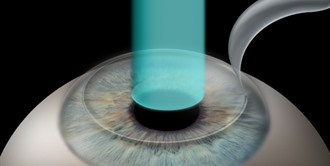Laksik is a common term that is used when describing visual corrective surgery. It is actually called Refractive Surgery as it corrects refractive errors - visual problems such as nearsightedness, farsightness, astigmatism and presbyopia. There are many Refractive Surgery options available, however Laksik is the most common and well known.
What Is A Refractive Error ?
For us to see images correctly light rays need to enter our eye and form a sharp focal point on the retina. The retina is a lining at the back of the eye which receives the light rays and sends signals via the optic nerve to the brain which in turn interprets these signals into the images we see. A refractive error happens when the curvature of the cornea or the natural lens in your eye is not perfect, these imperfections cause the sharp point of focus to miss the retina. In the case of farsightedness the focal point is focused beyond the retina, for nearsightedness the image is focused in front of the retina and for astigmatic patients the image is blurry or stretched out. This means that the brain doesn’t receive clear signals to interpret into an image.
Prescriptive spectacle lenses and contact lenses work by altering the direction of the light before they enter the eye, ensuring the focal of point is moved onto the retina providing signals to the brain for correct visual recognition. Refractive surgery aims to change the shape of the cornea therefore ensuring that the light rays focus precisely on the retina.
When To Consider Refractive Surgery
Refractive surgery should ideally be considered in your twenties to early thirties, when your optical prescription has been stable for approximately 2 years. You can expect refractive surgery to eliminate the need for spectacles or contact lenses for a number of years, how many varies as natural eye changes can occur. By the time you reach early to mid 40’s your optical prescription will start to change again due to Presbyopia, this is a natural aging process for the eye and you’ll find you will start to need reading spectacles. Frameless vision might become a little tricky to manage through your forties to early fifties as you find you will need corrective lenses for reading as well as distance. Multifocal lenses are the option here and you can get frameless vision with multifocal contact lenses.
The good news is vision without spectacles is still an option when your optical prescription stabilises again in your 50’s. At this stage a Clear Lens Extraction (CLE) , also referred to as Refractive Lens Exchange is a more likely surgical procedure. CLE replaces your natural lens with either a multifocal lens or lenses for mono vision (one eye reading and one eye distance). It is a good idea to trial these vision options with the use of contact lenses before your natural lens is replaced by surgery. The reason why CLE is often used, is it future proofs your surgically corrected vision by removing the potential for cataracts to develop later in life.

